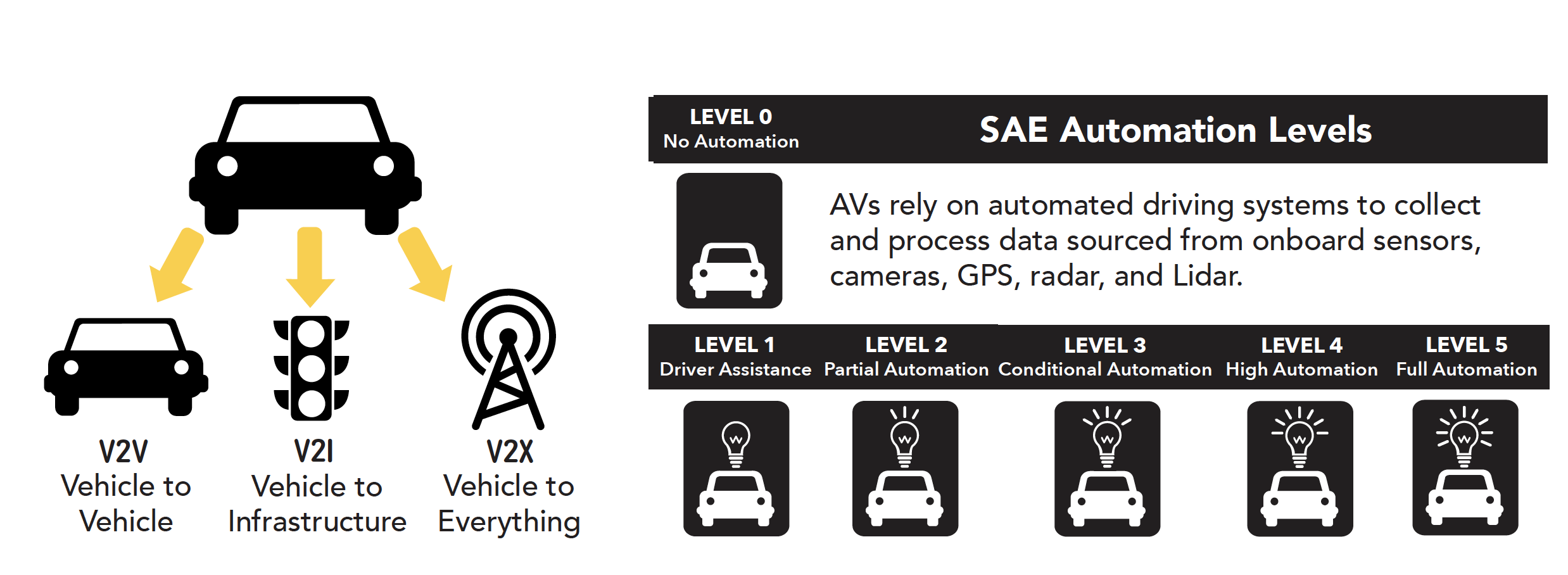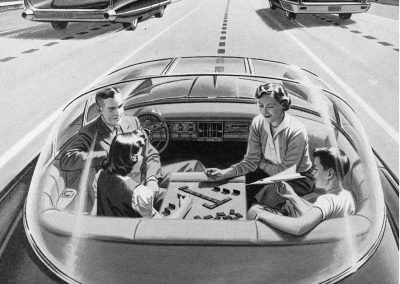OVERVIEW
Introduction
Since the 1930s visionaries in the automotive industry have dreamed of a future in which driverless vehicles move safely and effortlessly across road networks. Until recently, this dream felt impossibly distant. And every aspect of our transportation system has been designed and regulated under the assumption that human drivers operate vehicles. But the era in which federal, state, and local transportation officials can make decisions based on the idea that a person will always maintain full control of a vehicle is rapidly closing. In the years ahead, the number and type of connected and automated vehicles (CAVs) will gradually increase. CAVs are poised to transform the nature of passenger, freight and public transportation in Kentucky, throughout the US, and around the world. Automakers and technology firms are field testing a growing number of vehicles equipped with CAV technologies. In addition to their safety benefits, CAVs can alleviate congestion, streamline logistical operations, enhance mobility, and foster economic growth by bolstering supply chain efficiencies.
In the US, upwards of 40,000 people die each year in vehicle crashes. Human error is a contributing factor in 94 percent of fatal crashes and over 90 percent of all crashes. Connected and automated driving systems, by informing drivers of hazards or reducing the role of human input, will reduce crash frequencies and prevent avoidable fatalities. The National Highway Traffic Safety Administration (NHTSA) has concluded that connected vehicle (CV) technologies can prevent up to 80 percent of unimpaired vehicle-to-vehicle crashes. And work from the Insurance Institute for Highway Safety has validated the safety benefits of CAV technologies, finding that vehicles with advanced driver assistance systems (ADAS) are less likely to be involved in crashes. One recent study estimated that safety benefits conferred by CAVs could produce savings of $500 billion per year in the United States.
With the growth in CAVs, transportation agencies are beginning to rethink how they solve difficult transportation planning issues. For example, agencies often address congestion by increasing capacity (e.g., widening roads). But emerging vehicle technologies can help mitigate congestion without needing to build infrastructure, resulting in taxpayer savings and faster improvements. Even at low adoption rates (5 percent), CAV technologies can facilitate speed harmonization and reduce bottlenecks. CAVs promise advances in other areas as well. Disabled populations and people with limited mobility will benefit immensely from driverless shuttles and driverless deliveries. In effect, CAVs can open up entirely new worlds to people who have lacked access to existing transportation options.
How soon CAVs will make up a large portion of the vehicle fleet is unclear. Researchers and transportation agencies have developed forecasts to project adoption rates. In 2020, 98 percent of all new vehicles sold in the US were equipped with ADAS. By 2030, over 90 percent of vehicles sold in the US are likely to have onboard CV technologies. Among individual purchasers, adoption rates for fully automated vehicles (i.e., without a steering wheel of foot pedals) will be slower. Some projections indicate they will make up around half of all new vehicle sales by 2050. But some industry analysts are more skeptical and believe it is unlikely that the US fleet of personal vehicles will consist entirely of fully automated vehicles before the end of the century. Attempting to negotiate this uncertainty, transportation agencies are brainstorming ways to develop, operate, and maintain road and bridge networks that accommodate CAVs and vehicles operated by human drivers.
The Kentucky Transportation Cabinet (KYTC) believes emerging vehicle technologies will play a critical role in building a safer transportation system and solving transportation challenges. This document advances a strategic vision that describes steps KYTC can take to achieve CAV readiness. The ideas and concepts presented here are compatible with the Cabinet’s other guidance and planning documents, such as the Strategic Highway Safety Plan and Long-Range Transportation Plan, and can inform decision makers agencywide to ensure KYTC continues to meet its goals and achieve its mission. The public, policymakers, and other stakeholders with an interest in learning about the Cabinet’s approach to adoption of emerging vehicle technologies can benefit from reading this document.
What Are Connected and Automated Vehicles?
Publications which discuss emerging vehicle technologies contain a grab bag of acronyms, many of which have overlapping meanings. To ensure clarity, this section carefully defines terms used throughout in this document.
Connected Vehicles (CVs)
A CV has equipment that lets it communicate with other vehicles (vehicle-to-vehicle, or V2V), infrastructure, (vehicle-to-infrastructure, or V2I), or everything in the roadway environment, including pedestrians, bicyclists, and roadway hazards (vehicle-to-everything, or V2X). CVs broadcast and/or receive messages that improve driver situational awareness, mobility, and safety (e.g., forward collision warnings, red light warnings). Messages are transmitted via dedicated short-range communications (DSRC), C-V2X (cellular vehicle to everything), or 5G C-V2X. DSRC has led the way among these technologies due to its reliability, low latency use of dedicated bandwidth, and prioritization of safety applications. It has shown great promise for truck platooning and can facilitate cooperative automation or electronically coordinated acceleration and braking. A new FCC rule reallocating portions of the 5.9GHz spectrum will likely lead to automakers focusing on C-V2X and 5G C-V2X for CV applications.
Clarifying Terminology
SAE International Standard J3016 defines levels of driving automation. For Levels 0-3, humans control some or all of the driving tasks, while for Levels 4 and 5 driving is entirely automated.
Advanced Driver Assistance Systems (ADAS) — Levels 0 – 2
- Technologies which assist drivers with dynamic driving tasks. Newer systems use data collected from sensors and cameras to facilitate automation and improve safety.
- Examples include blind spot monitoring, collision avoidance systems, adaptive cruise control, lane departure warning, forward collision warning, parking assistance.
Automated Driving Systems (ADS) — Levels 3 – 5
- Technologies which can assume full responsibility for driving a vehicle under some or all conditions. Only Level 5 systems fully automate driving in all conditions.
- ADS-equipped vehicles leverage hardware and software systems that collect and process data sourced from onboard sen-sors,cameras, GPS, radar, sonar, and Lidar.
Similar to a human driver, AVs can only plan and control for what they sense and perceive. Currently, AVs cannot see around corners or peer through several vehicles in front to discern what is ahead. When used together, CV and AV technologies amplify the capabilities of AV sensors.
Automated Vehicles (AVs)
AVs perform some or all of the functions a human driver is responsible for in vehicles that lack ADS (GHSA 2018). These vehicles execute facets of the dynamic driving task without a human driver directly controlling the steering, acceleration, and/or deceleration. The US Department of Transportation (USDOT) has adopted SAE’s J3016 standard and recommends that state legislatures and agencies do the same.
Naming and Education
Naming conventions remain under discussion within the industry. A 2019 report from the American Automobile Association (AAA) contained recommendations for naming ADAS. Partners for Automated Vehicle Education (PAVE) is a coalition of industry partners and non-profit organizations established to educate the public and policymakers about AVs. While issues related to naming and acronyms will eventually be settled, they remain in flux.
Legislative and Policy Efforts Related to Emerging Vehicle Technologies
- 37 states and Washington, D.C. have passed legislation, have had executive orders signed, or seen a combination of the two enacted which focus on AVs
- 31 states and the District of Columbia have authorized testing or deployment of AVs
- In July 2020, NHTSA found that on road testing and development activities is occurring in 40 states and Washington, D.C.
At the national level, through bipartisan efforts the US House of Representatives passed the SELF DRIVE Act in 2017 (HR 3388), however, the US Senate did not approve its own version of the bill, AV START (S.1886). Each house of Congress renewed its commitment to passing AV legislation in 2019 — the House and Senate developed and circulated draft legislation focused on federal advisory committees, expanding AV testing, and allowing exemptions that will let automakers build vehicles without components such as steering wheels or brake pedals if the USDOT grants approval.
In 2021 the USDOT issued the Automated Vehicles Comprehensive Plan, which defines three ADS-related goals:
- Promote collaboration and transparency with partners and stakeholders
- Modernize regulations to remove barriers to innovative vehicle designs and build safety-focused frameworks and tools to evaluate ADS technologies
- Work with partners and stakeholders to pursue research and demonstration activities to safely integrate ADS into trans- portation systems
This plan builds upon expanding the scope to all on-road transportation systems; committing to making regulatory process nimbler to help match the pace of private sector innovation; and continuing progress from AV 3.0: Preparing for the Future of Transportation (2018), which provides guidance on safely integrating automation into vehicle operations. Included among its recommendations are a number of best practices state, local, and tribal governments can use when developing AV policies and regulations. The report reaffirms USDOT’s commitment to prioritizing safety, remaining neutral on questions of technology, and modernizing regulations.
In Kentucky, KRS 281.764 authorizes the operation of commercial vehicle platoons. The statute defines the conditions under which platooning operations may occur. Motor carriers that want to operate a platoon must submit a written plan to the Department of Motor Vehicles and Kentucky State Police describing how it will function. All drivers whose vehicles are part of a platoon must hold a valid commercial driver’s license and remain behind the wheel at all times. Vehicles must display a marking that alerts other drivers and law enforcement that they may be part of a platoon. The Department of Vehicle Regulation will establish administrative regulations and specify what information is to be included in platooning plans.
The only enabling legislation on the books in Kentucky is KRS 281.764. However, more localized regulations have been introduced. For example, the Cincinnati/Northern Kentucky International Airport (CVG) recently enacted an ordinance that lets AVs and autonomous equipment operate on airport property. The airport now issues permits to applicants wanting to test these technologies and incorporate them into operations. Pilot testing of autonomous technologies in vehicles that move luggage between aircraft and the terminal is underway.
The State of CAV Testing
CAV testing is gaining momentum. Automakers, commercial truck manufacturers, technology firms (e.g., Waymo), and transportation network companies (TNCs) are currently testing Level 4 and 5 AV systems. Fully automated (level 4 ADS), low-speed shuttles are being piloted in many states. These shuttles are generally restricted to looped routes, with testing focused on passenger experience and shuttle interactions with other motorists, pedestrians, and bicyclists. Vehicles like this may play an important role in solving the first mile/last mile challenge (e.g., getting passengers from transit stops to their final destination, moving goods from a distribution hub to customers).
Despite the FCC’s decision to narrow the broader capability of the 5.9 GHz band, CV testing continues. Automakers are devising new methods to integrate CV technologies as they mature. The USDOT has funded several CV and CAV projects around throughout the US. In 2020, the NHTSA launched the AV Transparent and Engagement for Safe Testing Initiative website to increase public awareness of ADS developers who are validating laboratory and track-testing with controlled testing on public roads across the country. FHWA encourages collaborations focused on the research and development of Transportation Systems Management and Operations (TSMO) strategies and CAV technologies through its cooperative driving automation research mobility applications CARMASM program.
A recent Accelerated Innovation Deployment (AID) demonstration grant has given KYTC the opportunity to implement Automated Traffic Signal Performance Measures (ATSPMs) and CV technology on two corridors: US 231 in Bowling Green and KY 876/US 25 in Richmond. The Cabinet has installed advanced traffic signal controllers, advanced traffic detection devices, and V2I communications equipment. This project will also evaluate sophisticated traffic signal phasing and timing concepts, which are made possible by advanced traffic signal technologies. Key goals of the projects are improving safety, increasing travel time reliability, and adjusting signal timings more routinely in response to driver feedback. Evaluations of these corridors will help KYTC determine where to install new traffic control technologies and identify and implement efficient phasing and timing treatments. The Cabinet envisions this project providing the foundation for the widespread deployment of advanced signal technologies.
Because CV and AV technologies and testing are rapidly evolving, a full review of them is beyond the scope of this document. The Cabinet will remain attentive to new technologies, pilot studies, and other changes as they emerge. Maintaining up-to-date knowledge of the industry will be critical for helping KYTC develop CAV-related policies in the coming years.
History of AV Development
While the concept of AVs was first proposed at the 1939 World’s Fair, research did not begin at companies like General Motors and RCA until the 1950s. Research continued in the ensuing decades, with the pursuit of driverless vehicles gaining momentum in the early-1990s after Congress allocated $650 million in 1991 for the development and demonstration of AV technologies. In 1997 this culminated in a demonstration of an automated highway system. The Defense Advanced Research Projects Agency (DARPA) funded three DARPA Grand Challenges, in 2004, 2005 and 2007 – these AV competitions were instrumental for stimulating research into AV technologies.
Signal Phasing & Timing (SPaT) Challenge
Kentucky has a rich history of pioneering new transportation technologies. Nathan Stubblefield, a Kentucky farmer, invented radio broadcast and received the first wireless broadcast of human voice (1902). Garrett Morgan, a Kentucky native, filed one of the earliest patents for a traffic signal (1922) that he invented after witnessing a serious crash.
KYTC builds on this tradition today by participating in the SPaT Challenge, which encourages infrastructure owners and operators at the local and state levels to deploy DSRC-based V2I systems. At its outset one of the SPaT Challenge’s primary goals was to have DSRC infrastructure installed along at least one corridor or network (with a minimum of 20 signalized intersections) in all 50 states by 2020. The initiative has spurred work in 37 states and resulted in the installation of thousands of roadside units (RSUs).
The more recently launched Connected Fleet Challenge — established through a partnership between AASHTO, FHWA, the Institute of Transportation Engineers (ITE) and ITS America — asks agencies to install on one light-duty and one heavy-duty vehicle a 5.9 GHz DSRC onboard unit by 2021. The Cabinet is currently examining potential avenues for participating in this challenge.



